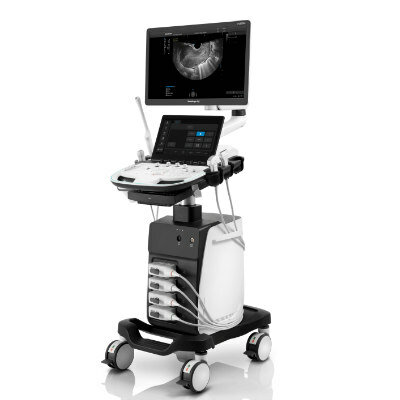New Imaging Technique Detects Aggressive Lung and Prostate Cancers
|
By MedImaging International staff writers Posted on 02 Jul 2024 |

Small cell lung cancer (SCLC) and neuroendocrine prostate cancer (NEPC) are types of neuroendocrine cancers, which develop in hormone-producing cells. SCLC is known for its rapid spread to other regions and lymph nodes in the chest. The five-year survival rate stands at 18% when it is diagnosed after it has spread beyond the lungs. NEPC, while rare, is highly lethal and lacks effective standard treatments. It may appear as a new cancer, referred to as “de novo,” or develop from more common prostate adenocarcinoma, often due to the effects of treatments like hormone therapy or chemotherapy. NEPCs are challenging to detect and usually require biopsies for diagnosis, posing an increasing challenge in prostate cancer management. However Now, a new imaging technology has been shown to enhance the detection of metastatic SCLC and NEPC, which conventional imaging methods might miss.
This advanced imaging method, developed at Memorial Sloan Kettering Cancer Center (MSK, New York, NY, USA), utilizes a radioactive tracer designed to bind to a specific cancer cell ligand known as DLL3, enhancing the visibility of these cells on PET scans. DLL3 is predominantly expressed in aggressive forms of SCLC and NEPC, aiding in the identification of patients who could benefit from new DLL3-targeting drugs currently under clinical evaluation. Furthermore, researchers are exploring ways to couple these drugs with radioactive materials to create a targeted treatment that spares healthy cells while eliminating cancer cells.
Named [89Zr]Zr-DFO-SC16.56, this imaging agent is a significant advancement in the field of theranostics, which combines diagnostic and therapeutic capabilities in a single agent. The imaging agent is injected into the body by a nuclear medicine physician, followed by its absorption by cancer cells that express DLL3. This process allows physicians to use PET scans to determine the extent of the cancer and guide treatment decisions. This agent not only detects minute metastases to the brain but may also be applicable to other cancers like thyroid cancer and neuroblastoma. Initial results from a pilot study published in The Lancet Oncology have shown that [89Zr]Zr-DFO-SC16.56 reliably identifies cancer cells with DLL3 in 18 patients, without raising safety issues. Plans are underway to further evaluate this agent in a larger cohort, with MSK receiving multiple grants to advance and validate this DLL3-focused technology.
“DLL3-targeting technology could be the next generation of theranostics, guiding new treatments for patients with small cell lung cancer or neuroendocrine prostate cancers who otherwise would have run out of options,” said MSK radiochemist Jason S. Lewis, PhD.
Related Links:
Memorial Sloan Kettering Cancer Center
Latest Nuclear Medicine News
- Novel Bacteria-Specific PET Imaging Approach Detects Hard-To-Diagnose Lung Infections
- New Imaging Approach Could Reduce Need for Biopsies to Monitor Prostate Cancer
- Novel Radiolabeled Antibody Improves Diagnosis and Treatment of Solid Tumors
- Novel PET Imaging Approach Offers Never-Before-Seen View of Neuroinflammation
- Novel Radiotracer Identifies Biomarker for Triple-Negative Breast Cancer
- Innovative PET Imaging Technique to Help Diagnose Neurodegeneration
- New Molecular Imaging Test to Improve Lung Cancer Diagnosis
- Novel PET Technique Visualizes Spinal Cord Injuries to Predict Recovery
- Next-Gen Tau Radiotracers Outperform FDA-Approved Imaging Agents in Detecting Alzheimer’s
- Breakthrough Method Detects Inflammation in Body Using PET Imaging
- Advanced Imaging Reveals Hidden Metastases in High-Risk Prostate Cancer Patients
- Combining Advanced Imaging Technologies Offers Breakthrough in Glioblastoma Treatment
- New Molecular Imaging Agent Accurately Identifies Crucial Cancer Biomarker
- New Scans Light Up Aggressive Tumors for Better Treatment
- AI Stroke Brain Scan Readings Twice as Accurate as Current Method
- AI Analysis of PET/CT Images Predicts Side Effects of Immunotherapy in Lung Cancer
Channels
Radiography
view channel
AI Detects Fatty Liver Disease from Chest X-Rays
Fatty liver disease, which results from excess fat accumulation in the liver, is believed to impact approximately one in four individuals globally. If not addressed in time, it can progress to severe conditions... Read more
AI Detects Hidden Heart Disease in Existing CT Chest Scans
Coronary artery calcium (CAC) is a major indicator of cardiovascular risk, but its assessment typically requires a specialized “gated” CT scan that synchronizes with the heartbeat. In contrast, most chest... Read moreMRI
view channel
New MRI Technique Reveals Hidden Heart Issues
Traditional exercise stress tests conducted within an MRI machine require patients to lie flat, a position that artificially improves heart function by increasing stroke volume due to gravity-driven blood... Read more
Shorter MRI Exam Effectively Detects Cancer in Dense Breasts
Women with extremely dense breasts face a higher risk of missed breast cancer diagnoses, as dense glandular and fibrous tissue can obscure tumors on mammograms. While breast MRI is recommended for supplemental... Read moreUltrasound
view channel
Wireless Chronic Pain Management Device to Reduce Need for Painkillers and Surgery
Chronic pain affects millions of people globally, often leading to long-term disability and dependence on opioid medications, which carry significant risks of side effects and addiction.... Read more
New Medical Ultrasound Imaging Technique Enables ICU Bedside Monitoring
Ultrasound computed tomography (USCT) presents a safer alternative to imaging techniques like X-ray computed tomography (commonly known as CT or “CAT” scans) because it does not produce ionizing radiation.... Read moreGeneral/Advanced Imaging
view channel
CT Colonography Beats Stool DNA Testing for Colon Cancer Screening
As colorectal cancer remains the second leading cause of cancer-related deaths worldwide, early detection through screening is vital to reduce advanced-stage treatments and associated costs.... Read more
First-Of-Its-Kind Wearable Device Offers Revolutionary Alternative to CT Scans
Currently, patients with conditions such as heart failure, pneumonia, or respiratory distress often require multiple imaging procedures that are intermittent, disruptive, and involve high levels of radiation.... Read more
AI-Based CT Scan Analysis Predicts Early-Stage Kidney Damage Due to Cancer Treatments
Radioligand therapy, a form of targeted nuclear medicine, has recently gained attention for its potential in treating specific types of tumors. However, one of the potential side effects of this therapy... Read moreImaging IT
view channel
New Google Cloud Medical Imaging Suite Makes Imaging Healthcare Data More Accessible
Medical imaging is a critical tool used to diagnose patients, and there are billions of medical images scanned globally each year. Imaging data accounts for about 90% of all healthcare data1 and, until... Read more
Global AI in Medical Diagnostics Market to Be Driven by Demand for Image Recognition in Radiology
The global artificial intelligence (AI) in medical diagnostics market is expanding with early disease detection being one of its key applications and image recognition becoming a compelling consumer proposition... Read moreIndustry News
view channel
GE HealthCare and NVIDIA Collaboration to Reimagine Diagnostic Imaging
GE HealthCare (Chicago, IL, USA) has entered into a collaboration with NVIDIA (Santa Clara, CA, USA), expanding the existing relationship between the two companies to focus on pioneering innovation in... Read more
Patient-Specific 3D-Printed Phantoms Transform CT Imaging
New research has highlighted how anatomically precise, patient-specific 3D-printed phantoms are proving to be scalable, cost-effective, and efficient tools in the development of new CT scan algorithms... Read more
Siemens and Sectra Collaborate on Enhancing Radiology Workflows
Siemens Healthineers (Forchheim, Germany) and Sectra (Linköping, Sweden) have entered into a collaboration aimed at enhancing radiologists' diagnostic capabilities and, in turn, improving patient care... Read more

















.jpeg)


